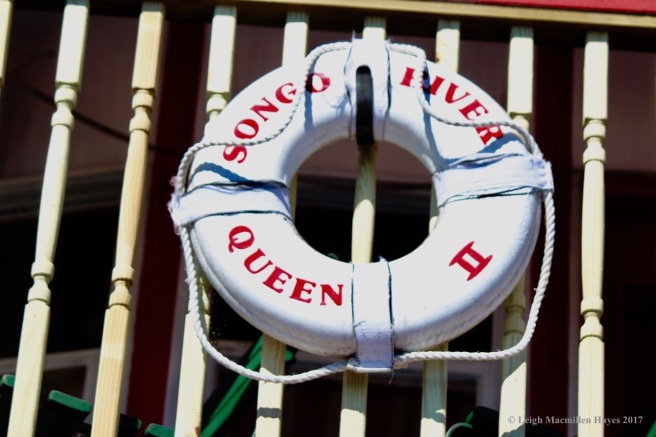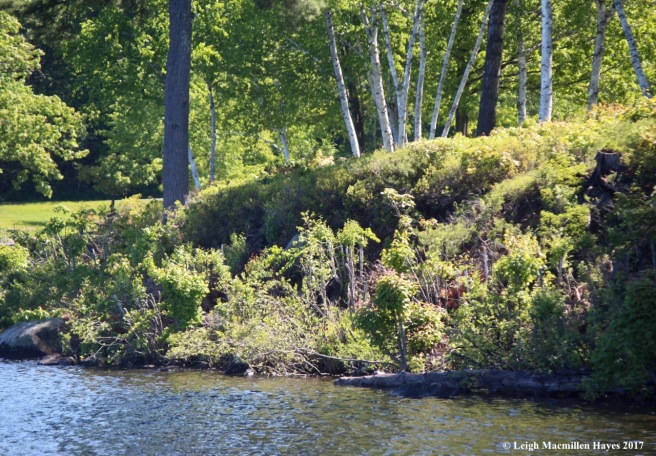Shouts of “Hey You!” echoed across Long Lake in Naples, Maine, this morning as sixth grade students from Oxford Hills enjoyed a cruise sponsored by the Lakes Environmental Association aboard the Songo River Queen II, a replica of the famed Mississippi River Paddle Wheelers. For the past twenty years or so, LEA has offered this event to those who have completed the Living Connections Program in the Lake Region Schools and as a special program for students from several other districts, such as Oxford Hills.

This culminating activity brings all the lessons students have learned about shoreland zoning and water quality to life in an engaging and interactive way.

After what seemed like months of rain, it was a beautiful morning as Captain Kent steered the boat away from the dock and onto the 11-mile-long lake.

As the tour began, LEA’s talented teacher/naturalist Mary Jewett, quizzed the kids.

They expressed their knowledge about watersheds, lake hydrology, phosphorus and other nutrients, chlorophyll, algal blooms, vegetated buffers, erosion control, thermocline, stratification and turnover, and received prizes for each correct answer. I’m always impressed by their responses.

They’re able to point out vegetated buffers . . .

and recognize that some lakefront properties built within the 100-foot setback are older than the shoreland zoning law and therefore grandfathered.

In the midst of it all, Captain Kent suddenly made Mary aware of a violation occurring on shore. Several women shoveled sand out of a wheelbarrow and spread it with rakes.

Encouraged by Mary, the kids shouted, “Hey You!” The women continued to spread the sand so the kids shouted again—only this time they were even louder. On shore, the culprits looked surprised. Using the loudspeaker system, Mary explained that it’s illegal to add sand to the beach.

The women quickly retreated, dumping the wheelbarrow in the process. The kids caught on that this was a role playing situation, but it created opportunities to discuss the implications–such as the fact that dumping sand can cause significant problems for the lake because it contains phosphorus, which contributes to decreased water clarity and algal blooms. Wildlife is also affected, e.g. decreased spawning habitat for fish, and increased opportunities for invasive aquatic plants like variable-leaf milfoil.

Mary continued to question the kids as the boat poked along, until another “Hey You!” moment. One woman was spotted spreading fertilizer (flour in this case) with a flourish, while another sprayed what appeared to be weedkiller on the vegetative buffer. The kids were reminded that topical fertilizers often contain phosphorus and other nutrients that wash into the lakes.

At the same property, a man mowed the lawn using the lowest setting (or so it looked from the boat). Short grass is even more likely to allow those nutrients to wash into the water.

The next violation involved a group of people trimming and removing the vegetated buffer. The students know the buffer is the last line of defense between a home and the lake because it provides a filter for any run-off, thus helping to keep excessive nutrients, sediment and storm water out of the lake. Native trees, shrubs, flowers and ground cover should be left in place.

Like the other offenders, this group hastily ran away . . .

and hid behind the trees.

Following the third stop, the boat paused in the middle of the lake, where Mount Washington was visible. Students rotated through water testing stations where they practiced using such devices as a secchi disk, dissolved oxygen meter, Van Dorn water sampler, and core sampler. I was in charge of the core sampler and we talked about how the hose is lowered to one meter below the thermocline, that mid-point at which the temperature decreases and sunlight cannot penetrate. (Think about doing a cannon ball off the dock and hitting the spot where the temperature is suddenly freezing–or so it feels on a hot summer day.) We talked about how the water is tested in a lab for chlorophyll, phosphorus, pH, color and more. And then they tried gathering a water sample. One student lowered the weighted end of the clear, plastic hose into the water, while the others held onto the rest of it. When I said “Crimp and cover,” a second student crimped the hose and a third covered the far end. Quickly, the first student raised the weighted end, the other two let go and working together, all raised the hose high and tried to “walk” the water down it and into a container. Today, I think we gathered the most water I’ve seen in all the years I’ve volunteered for this activity.

Once students had rotated through all of the stations, Mary’s quiz continued as we traveled along the eastern shore. Volunteers asked questions, though I let Mary ask mine, and again the students who answered correctly were rewarded.

Because they were on the lookout, one of the kids noticed people wearing hardhats and attempting to cut pine trees within mere feet of the lake.

They are quickly admonished by this now savvy group, though the “workers” couldn’t believe they’re being picked upon. Mary did remind the kids that shoreland zoning laws do allow homeowners to limb up to 1/3 the height of a tree in order to maintain a view.

Close by, a man washed his laundry—yes, in the water. Under state law, it is illegal to intentionally introduce foreign substances, including soap, into the water. (He was supposed to “bathe,” but the temperature is a wee bit chilly yet.)

It didn’t end there. As the boat passed by the Naples Town Beach, the kids noticed a group gathered on the dock drinking and then tossing empty cans.

You know by now what happened.

Though one guy did run back . . .

to get the boom box.

At last Kent steered the boat back toward the dock.

The cruise had come to an end, but by seeing the volunteer actors on shore, students made the connection between their in-class learning and real life situations when it comes to water quality.

Oh, and before we had initially headed out, Mary spotted a huge dragonfly exoskeleton by the causeway and LEA’s Education Director, Alanna Doughty, climbed over the railing to fetch it. As Mary pointed out to the kids when she held the exoskeleton up, this is what it’s all about–clean water for aquatic species and for us.
Hey You! Think about your actions and be the difference.

What a nice day for the kids…what a lot of work for you two to coordinate all of those people and playacting!
“I was so much older then, I’m younger than that now.” Bob Dylan
Sent from my iPad
>
LikeLiked by 1 person
It was a great day for them. I had nothing to do with organizing it–I just had to show up and do my bit with the core sampler. It’s a lot of fun.
LikeLike
Awesome learning experience for all! The kids will always remember this experience. Kudos to all of you! Great real life experience.
LikeLiked by 1 person
It really is, Lynn. Mary was once one of those kids and now she’s teaching them!
LikeLike